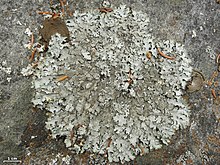| Parmelia | |
|---|---|

| |
| Parmelia saxatilis | |
| Scientific classification | |
| Domain: | Eukaryota |
| Kingdom: | Fungi |
| Division: | Ascomycota |
| Class: | Lecanoromycetes |
| Order: | Lecanorales |
| Family: | Parmeliaceae |
| Genus: | Parmelia Ach. (1803) |
| Type species | |
| Parmelia saxatilis | |
| Synonyms[1] | |
Parmelia is a genus of medium to large foliose (leafy) lichens.[3]: 78 It has a global distribution, extending from the Arctic[4] to the Antarctic continent[5] but concentrated in temperate regions.[6] There are about 40 species in Parmelia.[7] In recent decades, the once large genus Parmelia has been divided into a number of smaller genera according to thallus morphology and phylogenetic relatedness.
It is a foliaceous lichen, resembling a leaf in shape. The ends of the leaf-like lobes are often squarish-tipped.[3]: 78 The upper surface is pale bluish-gray to light brown in direct sunlight, with a network web-like ridges and depressions.: 78 The lower surface is black and has rhizines anchoring it to the substrate.[3]: 78 In general, Parmelia have a dark lower side with rhizines ('rootlets') that attach the lichen to its substrate. The upper side may be several colours - grey, yellow, brown - and may have reproductive organs on it. These may be apothecia (ascospore-producing bodies), isidia or soralia (both vegetative structures). In between these two layers is the medulla, which contains the algal component of the lichen.
- ^ Cite error: The named reference
Species Fungorum synonymywas invoked but never defined (see the help page). - ^ Cite error: The named reference
Massalongo 1860was invoked but never defined (see the help page). - ^ a b c Field Guide to California Lichens, Stephen Sharnoff, Yale University Press, 2014, ISBN 978-0-300-19500-2
- ^ Skult H (1985) A New Subspecies of Parmelia omphalodes Ascomycetes Described from the Arctic. Annales Botanici Fennici 22, 201-6.
- ^ D.C. Lindsay (1973) Notes on Antarctic lichens: IV. The genera Cetraria Hoffm., Hypogymnia (Nyl.) Nyl., Menegazzia Massal, Parmelia Ach. and Platismatia Culb. et Culb. British Antarctic Survey Bulletin 36, 105-114.
- ^ Bisby, Guy Richard; Ainsworth, G. C.; Kirk, P. M.; Aptroot, André (2001). Ainsworth & Bisby's Dictionary of the fungi / by P. M. Kirk... [et al.]; with the assistance of A. Aptroot... [et al.] Oxon: CAB International. p. 378. ISBN 978-0-85199-377-5.
- ^ Cite error: The named reference
Ossowska et al. 2019was invoked but never defined (see the help page).